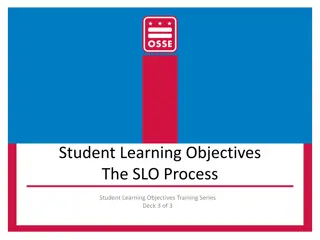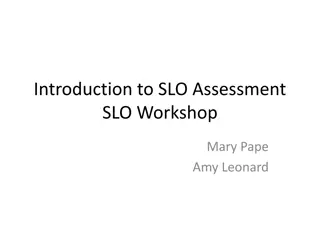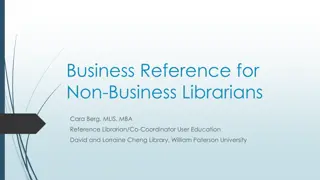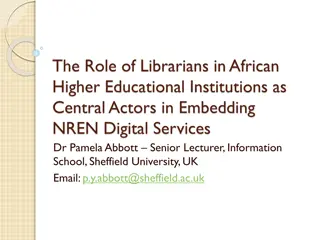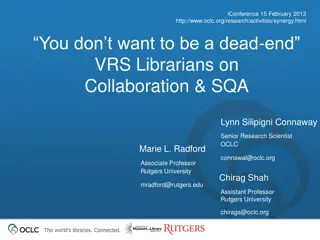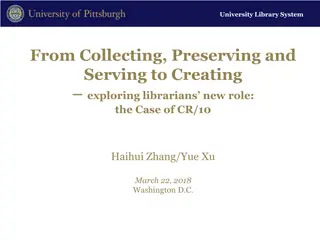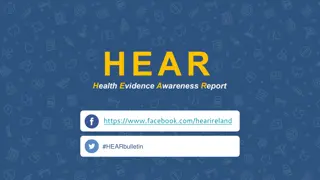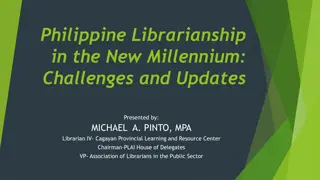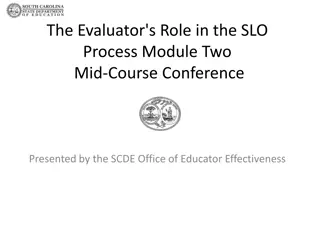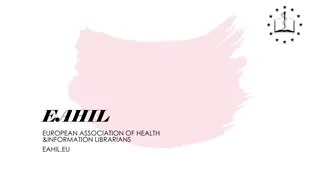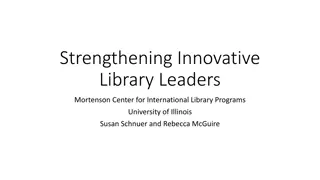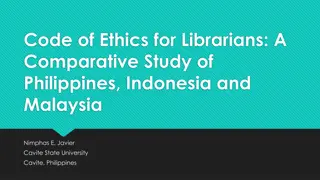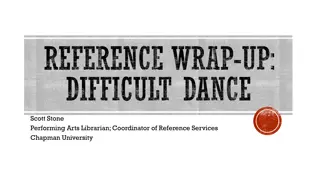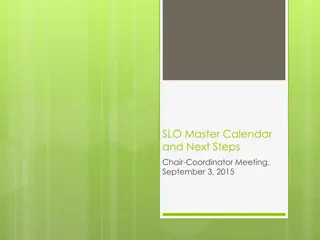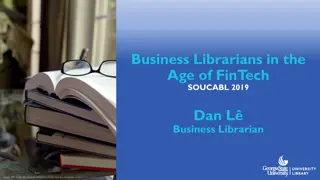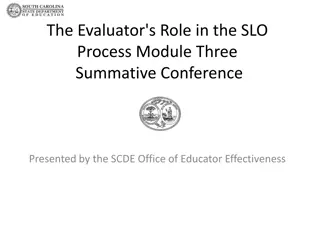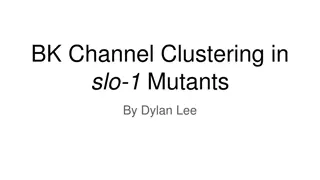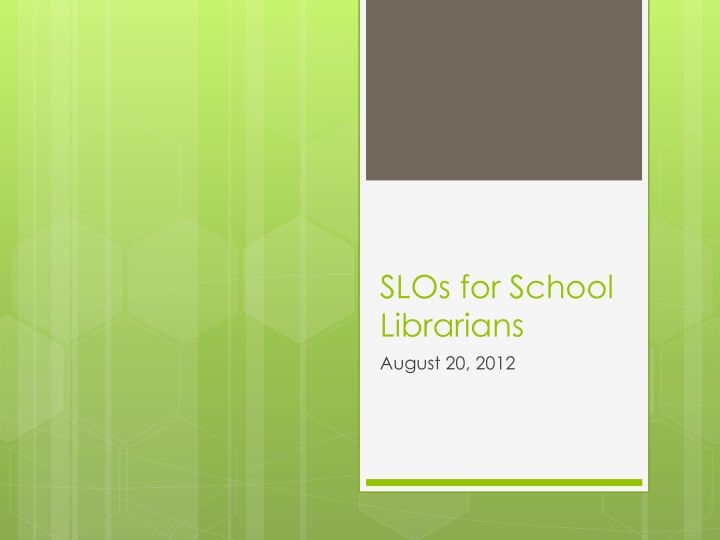
Student Learning Objectives (SLOs) for School Librarians
Explore the significance of Student Learning Objectives (SLOs) in education, focusing on goals, collaboration, and driving better practices. Learn about the SLO process and its impact on student learning outcomes. Discover who determines criteria for growth measures in the education system.
Download Presentation

Please find below an Image/Link to download the presentation.
The content on the website is provided AS IS for your information and personal use only. It may not be sold, licensed, or shared on other websites without obtaining consent from the author. If you encounter any issues during the download, it is possible that the publisher has removed the file from their server.
You are allowed to download the files provided on this website for personal or commercial use, subject to the condition that they are used lawfully. All files are the property of their respective owners.
The content on the website is provided AS IS for your information and personal use only. It may not be sold, licensed, or shared on other websites without obtaining consent from the author.
E N D
Presentation Transcript
SLOs for School Librarians August 20, 2012
There are known knowns. These are things we know that we know. There are known unknowns. That is to say, there are things that we know we don't know. But there are also unknown unknowns. There are things we don't know we don't know. ~Donald Rumsfeld
Goals of SLOs What students need to know and be able to do at the end of the year SLOs place student learning at the center of the conversation SLOs are critical part of all great educator s practice SLOs are an opportunity to document the impact educators make with students SLOs provide principals with critical information that can be used to manage performance, differentiate and target professional development, and focus supports for teachers The SLO process encourages collaboration within school buildings
SLO process drives collaboration which drives better practices. ~Mary Ratzer
Who Does What? STUDENT LEARNING OBJECTIVES From NYSED SLO GUIDANCE MAY 2012 WHAT IS DECIDED BY THE STATE VERSUS DISTRICT LEVEL AND/OR SCHOOL/TEACHER LEVELS FOR COMPARABLE GROWTH MEASURES?
I apologizevery wordy slides coming up!
The State determines the following for comparable growth measures: The overall SLO framework, including required elements. Requirements in the context of Regulations: Requirements for which teachers must set SLOs and which teachers must have State-provided growth measures. Requirements for which assessments must be used, and which are allowable options, under the Regulations. Requirements around scoring: The scoring ranges and categories for the measures of student growth subcomponent. Rules for scoring SLOs that include a State-provided growth measure. Rules for scoring multiple SLOs. Provides training to Network Teams and Network Team Equivalents on SLOs prior to 2012-13 school year.
Districts(in the context of State Regulations and frameworks) determine the following: Assess and identify their unique priorities and needs. Identify who in the District will have State-provided growth measures and who must have SLOs as comparable growth measures as per the State s rules. District-wide rules for how specific SLOs will get set. Expectations for scoring SLOs and for determining teacher ratings for the growth component, within State rules. District-wide processes for setting, reviewing, and assessing SLOs in schools. Create processes to ensure that any assessments are not scored by teachers and principals with a vested interest in the outcome of the assessment they score, and address assessment security issues. Establish which decisions are made at the District level versus in schools by principals, and/or principals with teachers. Provide or arrange for training to lead evaluators.
Schools(in the context of State Regulations and frameworks, and District decisions) determine the following: Implement State and District-determined processes. Make choices as needed when District leaves flexibility to schools. Ensure that lead evaluator approves each teacher s goals and monitors/assesses results. Ensure all assessments are secure and that any assessments, including those used as evidence for SLOs, are not scored by teachers and principals with a vested interest in the outcome of the assessment they score.
Teachers(in the context of State Regulations and framework, District decisions, and school decisions) determine the following: Propose, in consultation with lead evaluator, SLOs and targets based on District and school requirements. Obtain all possible data on students to best inform baseline, starting level of student learning. Reflect on student learning results and consider implications for future practice.
August 13 Guidance B12. When must school librarians be evaluated under Education Law 3012-c? Only classroom teachers and building principals must be evaluated under Education Law 3012-c. "Classroom teacher" is defined as a teacher in the classroom teaching service who is a teacher of record. Librarians who are certified as a library media specialist or school media specialist (library) are teachers in the classroom teaching service. For the 2012-2013 school year, teacher of record is defined as a teacher who is primarily and directly responsible for a student s learning activities that are aligned to the performance measures of a course, consistent with guidance. Therefore, a certified librarian who is not a teacher of record is not a "classroom teacher" and therefore would not need to be evaluated under Education Law 3012-c. However, if a certified librarian is a teacher of record, he/she would be considered a "classroom teacher" and therefore must be evaluated under Education Law 3012-c.
In English: Only a teacher of record needs an SLO District defines what a teacher of record is on the safe side, anyone with regularly scheduled classes! The Guidance says only for 2012-2013 school year, will probably come next year So, why should we do one
Lets look at Examples http://teachersites.schoolworld.com/webp ages/SLS/common.cfm?subpage=1562946 Shortcut: www.monroe2boces.org/sls Click on Common Core Central Click on APPR
Parking Lot important yes, but they can bog us down! Student population Length of an instructional unit Teacher of record Who will grade assessments Librarians do not have an approved state wide curriculum for standards
Things to Consider Using last year s test as this year s baseline assessment. Multiple SLOs provide you with more opportunities to show growth in student learning. Consider exceeding the minimum population requirements. Cannot fill in target(s) until baseline assessment is complete.
"Assessment should be deliberately designed to improve and educate student performance, not merely to audit as most school tests currently do." -Grant Wiggins, EdD., president and director of programs, Relearning by Design, Ewing, New Jersey
What IS Assessment? Table top twitter In table groups, one person at a time writes one word on the chart in response to the question: What is assessment? No one talks You can write as many times as you want 3 minutes Be ready to share
Sowhat IS assessment??? Educational assessment is the process of documenting, usually in measurable terms, knowledge, skills, attitudes and beliefs. Assessment can focus on the individual learner, the learning community (class, workshop, or other organized group of learners), the institution, or the educational system as a whole. http://en.wikipedia.org/wiki/Educational_assessment
Effective assessment will Provide diagnostic feedback Evaluate progress Relate to a student s progress
Types of assessment: Formative Used to gather student feedback Used to improve instruction Done during instruction Summative Reflect student learning Given at the end of a unit of study
Think, pair, share What are some assessments you currently use? Are they formative or summative?
Authentic assessment could be Observation Essays Interviews Performance tasks Exhibitions and demonstrations Portfolios Journals Teacher-created tests Rubrics Self- and peer- evaluation
High & Low-Inference Constructed Response Questions Key Components of CR Items: Task: a specific item, problem, question, prompt, or assignment Response: Any kind of performance to be evaluated, including short/extended answer, essay, presentation, & demonstration Rubric: scoring criteria used to evaluate responses Scorers: people who evaluate responses (ETS, 2005)
Steps to Writing Constructed Response Questions For Short Response Questions: Measures targeted reasoning skill Task is clearly specified Question can be answered in allotted time Avoid choices among several questions Measures higher order thinking skills (Upper Levels of Bloom s Taxonomy)
Item Review Guidelines Requires Content Experts Item Coding: Content (Aligned to correct Learning Standard-See Common Core Exemplars) & Cognition (e.g. Bloom Taxonomy; Webb s Depth of Knowledge)
Webbs Depth of Knowledge Level Description Level 1 Recall: recall of a fact, information, or procedure Level 2 Skill/Concept: use of information or conceptual knowledge, two or more steps, etc. Level 3 Strategic Thinking: requires reasoning, developing plan or a sequence of steps, some complexity, more than one possible answer. Level 4 Extended Thinking: requires an investigation, time to think and process multiple conditions of the problem (www.wcer.wisc.edu)
Flying the plane while were building it ..\Common Core\Regional CCS Unit Writing for 10711\EDS_Airplane.wmv
Lets break for lunch!!!! Enjoy!!!
Now What We will spend the remainder of our time working on assessments The assessments will be regional: Monroe 2 Orleans, Monroe 1, RCSD, and WFL We will be using the Information Fluency Continuum for our standards

